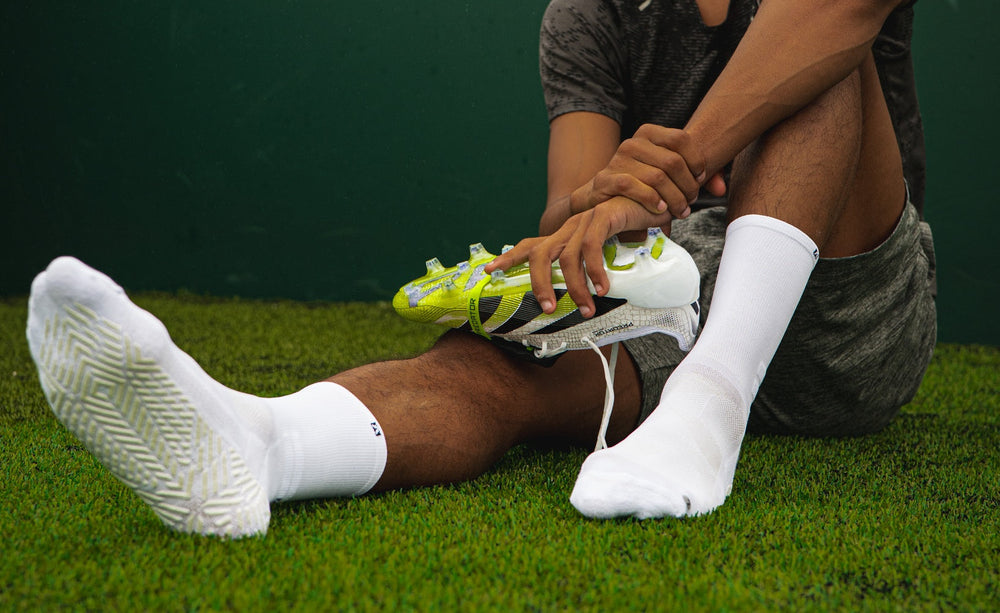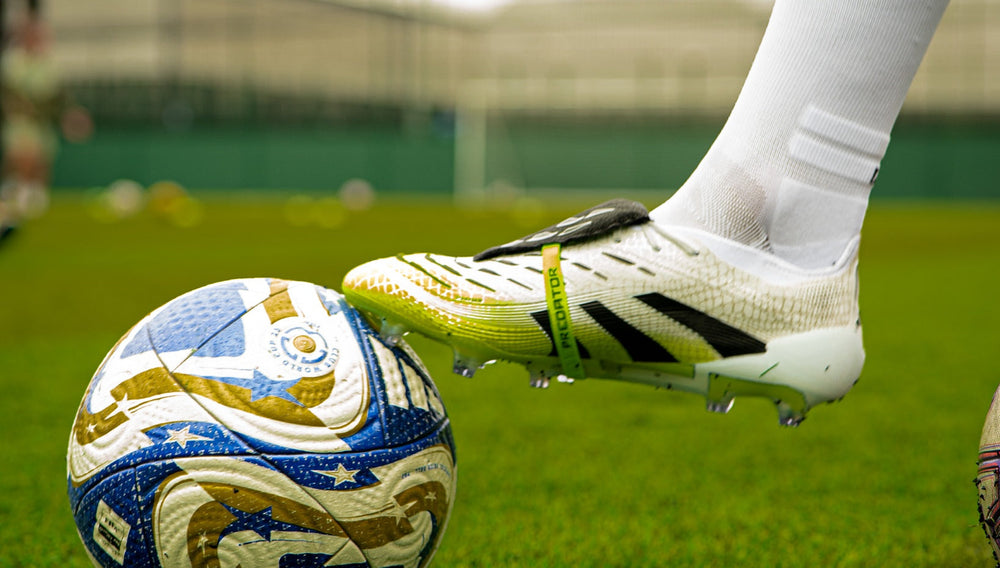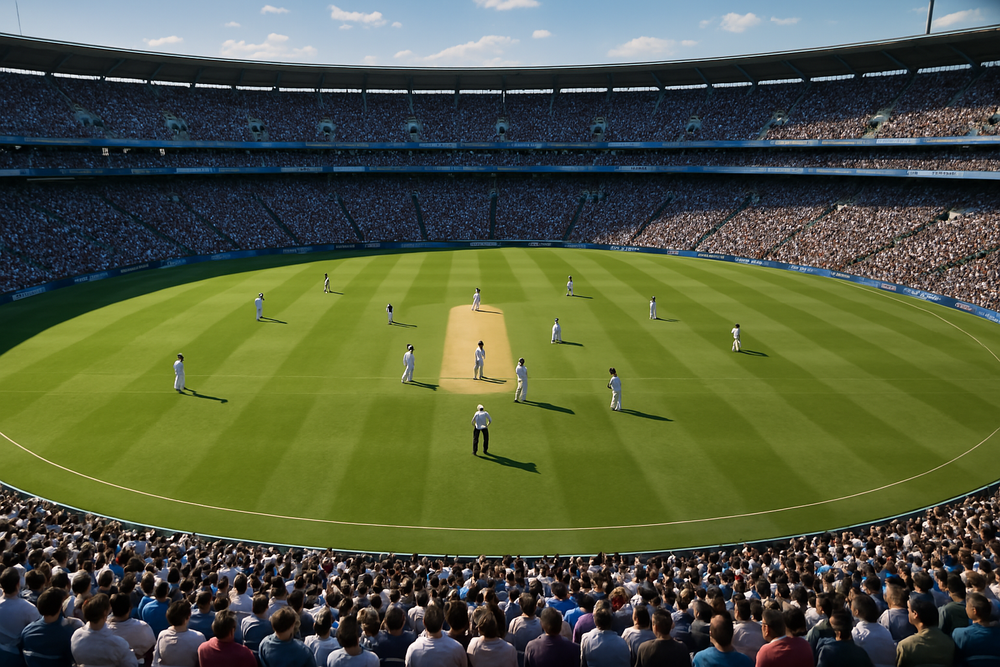Welcome to the most comprehensive guide to football grip socks on the web. This article explains what grip socks are, why they were invented, how they evolved from locker room experiment to pro standard, the science behind traction and moisture control, league regulations, care best practices, and a detailed buyer’s framework for every player including kids and academy pathways. You will also find a deep dive into AdvantEdge technology with links to product pages and bundles.
```What Are Football Grip Socks
Football grip socks are performance socks with traction elements placed on the sock exterior and sometimes also on the interior. The goal is to minimise internal slip at the foot sock boot interfaces so the player’s intent translates into movement more directly. Less slip means crisper acceleration, more stable deceleration, and tighter directional control during turns, chops and step overs. Modern models combine traction with mapped compression, moisture management and anatomical knitting so the sock acts like an extension of the foot.
A Complete History of Grip Socks
Early experiments and the problem to solve
For decades players used ad hoc methods to stop foot movement inside boots. Some doubled up socks for bulk. Others sprinkled rosin or roughened insoles. Tape was applied around arches in the hope of anchoring the foot. These hacks delivered temporary help but caused new problems such as pressure points, blistering or lost boot feel. The core problem remained micro slip during explosive actions that blurred proprioception.
From idea to early prototypes
The first purpose built non slip socks arrived when innovators applied polymer pads to the sock sole in a repeatable pattern. Instead of one large sticky panel that felt clumsy, smaller distributed nodes created friction without adding thickness. Word spread through training grounds and changing rooms because the improvement was immediately felt when planting for a cut or striking the ball. Players began cutting the feet off team socks, pulling the team leg sleeves over short grip socks to stay within kit rules while keeping the performance benefit.
Professional adoption and public awareness
By the early to mid 2010s television broadcasts and side line photography made the set up visible to fans. Close ups of ankles showed white or team colored grip socks underneath cut team socks held together with tape that matched the outer color. As more elite players adopted the accessory, younger age groups copied the practice and retailers began stocking multiple colorways to align with club kits. The category moved from novelty to essential equipment.
Innovation wave two
Once simple traction was established, innovation focused on how the entire foot interacts with the boot. Engineers mapped pressure distribution during football specific actions like lateral cuts, hop steps and decelerations. This led to denser patterns under the big toe and lateral forefoot, refined heel cups, and support structures that stabilised the midfoot without numbing feel. Moisture control improved with micro denier yarns and venting zones. Fit became anatomical with left and right specific knitting and flat linked toe seams.
Where we are now
Today grip socks form a mature category with two main branches. The first is match optimised socks that balance traction with low bulk and precise fit. The second is training and recovery focused socks that prioritise cushioning and durability for daily grind on abrasive turf. Many players use a rotation match pairs reserved for games and sharper sessions, and training pairs for heavy workloads. Kids and academy players benefit significantly because their boots change often and surfaces vary week to week.
Biomechanics of Slip, Force Transfer and Control
Understanding why grip socks help starts with basic physics. When the foot accelerates inside the boot, inertia resists the change in motion. If the sock surface is low friction, the foot slides forward or laterally before the boot walls and insole load up. That brief delay reduces the peak force delivered to the ground and forces the body to make compensatory micro steps to stabilise. Multiply that by dozens of accelerations and turns in a match and the loss of efficiency becomes meaningful.
Grip socks raise the coefficient of friction between sock and insole and, in dual interface designs, between skin and sock. The aim is not to glue the foot in place but to reduce unnecessary shear. With less shear the ankle and knee work through intended ranges, ground contact times are cleaner, and proprioceptive feedback is more accurate. Players often describe the sensation as feeling planted without feeling stuck.
Pressure zones and traction mapping
Football movement loads the big toe, first metatarsal head and the lateral forefoot during push off and cutting. The heel experiences high normal force during braking. Traction pads placed densely in these areas and slightly more sparsely elsewhere deliver control without bulk. The best maps trace foot pressure data captured from real football drills rather than generic running gaits.
Compression and arch stability
Compression bands around the midfoot reduce sock creep and support the plantar fascia. A well designed band feels like a gentle cradle rather than a tight tourniquet. Around the Achilles a taller cuff with zoned compression helps the heel counter of modern boots hold the calcaneus securely which reduces rubbing and improves heel lock.
Materials Science and Sock Engineering
Material choice governs comfort, moisture transport, strength and shape retention. High wicking polyester microfibers move sweat off the skin quickly so the interface stays drier. Nylon adds abrasion resistance and structural strength in high wear zones like the heel and toe. Elastane delivers stretch and recovery so the sock hugs the foot through the full session. Performance acrylics can feel plush while retaining wicking characteristics and have been associated with lower blister incidence compared with cotton in similar conditions. Cotton heavy blends feel comfortable at rest but absorb moisture and stay wet longer which can increase rubbing. For match play most athletes prefer synthetics or blends that limit cotton content.
Knitting techniques
Engineers combine flat knit panels for close boot feel, mesh zones for ventilation, and terry loop panels for impact comfort on firm ground or 3G. A flat linked toe seam prevents a ridge that could irritate inside snug boots. A deep Y heel cups the calcaneus securely so the sock does not migrate down the foot during sprints.
Durability considerations
Traction compounds must bond to yarns without becoming brittle. Low profile pads last longer when the compound remains flexible after repeated washing. Reinforcement yarns in the heel and toe resist blowouts during slide tackles or repetitive training on abrasive pitches. Stitch density and plating choices balance durability with breathability.
Traction Technologies Compared
External pads
Most designs place polymer pads on the outer sole to grip the insole. Advantages include predictable in boot feel and long life when the compound is well formulated. The trade off is potential thickness if pads are too tall.
Dual interface systems
Some premium socks add micro grip on the inside to lightly contact the skin or base sock. This reduces internal shear further and creates a bonded feel. The design must balance grip with skin comfort to avoid irritation.
Textured yarn approaches
Rougher yarns or looped structures add friction but typically less than polymer pads. They can be useful in training models where long wash cycles demand very high durability.
What to look for in real use
- Low profile pads that flex with the foot
- Coverage under heel, big toe and lateral forefoot
- Even pad spacing so pressure points do not form
- No harsh edges that could mark insoles
Performance Benefits and Limitations
Reported benefits cluster around control and comfort. Acceleration feels sharper because force transfer begins earlier. Deceleration feels more controlled because the foot does not surge forward against the boot wall. Direction changes are more precise and require fewer adjustment steps. Many players report fewer blisters because moisture is managed and shear forces are reduced. However, grip socks are not a magic solution. Poorly fitting boots, over tight lacing, old insoles or inadequate recovery will still limit performance. The socks are a precise tool that work best in a well considered footwear system.
Rules and Regulations in Detail
Competitions follow a common principle that any tape or material applied over the socks must be the same color as the part of the socks it covers. Practically that means if you wear a white grip sock under red team socks and the split is visible, referees can ask you to change. Solutions include team color grip socks or pulling the cut team sock fully over the grip sock so only one color shows. Branding size and placement also matters so avoid oversized visible marks that could breach local rules.
Use Cases Across Player Types
For wingers and attacking midfielders
Frequent cuts and feints demand strong lateral forefoot traction and a stable arch. Low bulk models pair well with modern snug boots to preserve touch. Training variants with slightly more cushioning can help on artificial surfaces during volume sessions.
For full backs and box to box midfielders
Repeated accelerations and decelerations place heavy load on the heel and midfoot. Look for dense heel pads, an assertive arch cradle and durable heel reinforcements.
For centre backs and target forwards
Power movements and aerial duels benefit from a planted base. Slightly more cushioning can assist comfort late in matches on firm ground while maintaining a locked in feel.
For goalkeepers
Lateral shuffles and set position hops stress the forefoot differently. A grippy big toe area helps with push offs while midfoot stability keeps the stance consistent.
Fit, Sizing and Boot Compatibility
Fit is the foundation of performance. Measure according to the brand’s chart and consider boot volume. If boots already fit race tight, choose the lightest, lowest bulk grip sock. If boots feel slightly roomy, a structured sock with a supportive arch band can restore a precision fit. Always test new socks in the boots you will wear for matches and perform football specific movements not just walking. Check that the heel cup sits correctly and the forefoot lies smooth without wrinkles.
How to Wear With Team Socks
- Put on grip socks and stand to seat the heel fully
- Roll a cut team sock over the top to meet kit color rules
- If taping match tape color to the outer sock and avoid excessive tension
- Smooth the ankle and forefoot to remove wrinkles before kick off
Care, Washing and Longevity
Turn socks inside out before washing to protect traction. Use a gentle cold cycle with mild detergent. Avoid bleach, fabric softeners and high heat tumble drying because they degrade elastane and traction compounds. Air drying preserves elasticity and pad flexibility. Store flat out of direct sunlight. For heavy training loads keep a rotation so each pair rests between sessions which helps recovery of elastane stretch.
Buying Guide, Checklists and Red Flags
Checklist
- Traction where football loads occur heel, big toe, lateral forefoot
- Snug fit without pressure points
- Flat linked toe seam and deep Y heel
- Moisture wicking fibers and mesh vents
- Clear care label and proven wash durability
- Club compliant colors and minimal visible branding
- Positive reviews from players on similar surfaces
Red flags
- Very tall pads that feel lumpy inside tight boots
- Loose cuff that slides during sprints
- Heavy cotton content that stays wet
- Toe seams you can feel with fingers
- Traction only under the arch with no heel or big toe coverage
Kids and Youth Specific Guidance
Kids benefit because grip socks create a consistent interface across changing boots and mixed surfaces. Choose youth sizing with gentle compression and robust stitching. Flat toe seams are important for comfort during growth spurts when sensitivity increases. For busy academy schedules buy bundles so a fresh pair is always available. Ensure colors align with club rules to avoid match day issues. Parents should check fit by asking the child to perform quick cuts and stops if the sock stays planted and there is no bunching it fits.
FAQs
Do grip socks really make a difference
For most players yes. The effect is most obvious during hard accelerations, sudden stops and sharp changes of direction. You feel planted with less wasted motion.
Are grip socks legal in matches
Yes when visible undersocks or tape match the team sock color and local competition rules are followed.
Can I wear them with orthotics
Yes. Check that traction zones align with pressure points and that overall thickness does not overcrowd the boot.
How long do they last
With proper care a quality pair typically performs well through a season of normal use. High heat dryers and abrasive turf shorten lifespan.
AdvantEdge Technology Deep Dive
AdvantEdge was built specifically for the realities of football. The traction map concentrates under the heel, big toe and lateral forefoot because pressure mapping from real football drills shows these zones take the highest torque during cuts and strikes. Pads are low profile and flexible so stack height stays minimal inside modern snug boots. The arch cradle stabilises the midfoot without deadening feel and the deep Y heel keeps the sock anchored during sprints. Fast wicking microfibers move sweat away from skin while mesh vents increase airflow. Selective terry loops add comfort on firm ground and 3G without blunting touch.
Two models help you tune fit. Pro Grip offers maximum match day lock in and balanced cushioning. Pro Lite is ultralight for tight boots and hot conditions. For academy players and regular trainers, Grip Sock Bundles and All Value Bundles deliver cost per wear savings and guarantee a fresh pair is always ready.
Glossary
- Compression mapping targeting different compression levels to match anatomy and movement
- Dual interface grip traction elements acting on both foot to sock and sock to boot surfaces
- Hydrophobic fibers yarns that repel water and move moisture to the fabric exterior
- Micro slip small internal movements that delay force transfer and reduce stability
- Proprioception sensory feedback that informs balance and body position
Further Resources
Explore more on fit, care and training setups in our guides. Visit the Size Guide, and shop All Grip Socks. For cold weather, pair with Lightweight Thermal Sports Gloves



